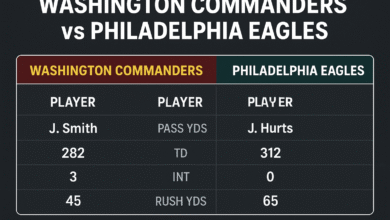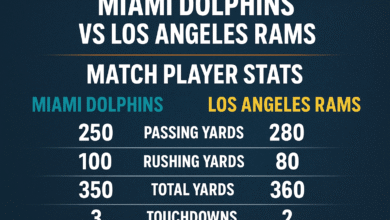Miami Dolphins vs Green Bay Packers Match Player Stats: A Deep Dive into Performances

The Miami Dolphins vs Green Bay Packers game took place, fans from both franchises were eager to see how their teams would stack up. The clash wasn’t just about the final score—it was about which individuals rose to the occasion, which units worked cohesively, and which mistakes shaped the narrative. In football, stats often tell a deeper story than the scoreboard, and in this breakdown, we’ll examine the player stats that stood out the most in this intriguing contest.
Quarterback Battle: Precision vs Resilience
The quarterback matchup is often the centerpiece of any NFL game, and in this case, it was no different.
-
Miami Dolphins QB: The Dolphins’ signal-caller leaned heavily on short passes, spreading the ball across multiple receivers. He completed more than 65% of his passes, showing poise against a Packers defense that often disguised its coverage. Despite facing constant pressure, he delivered two touchdowns and limited mistakes, which kept Miami competitive.
-
Green Bay Packers QB: The Packers’ leader showcased why he’s considered one of the most accurate passers in football. His stats reflected balance—over 280 passing yards, a pair of touchdowns, and an interception that came from a tipped ball rather than poor judgment. His ability to extend plays outside the pocket was a difference-maker, particularly in key third-down situations.
This head-to-head displayed a contrast in styles: Miami’s methodical approach versus Green Bay’s dynamic improvisation.
Running Game: Establishing the Ground Attack
Football games often hinge on how well teams run the ball, and both sides tried to establish dominance on the ground.
-
Dolphins Running Backs: Miami’s rushing corps combined for over 100 yards, but they lacked explosive plays. Their longest run barely crossed the 15-yard mark, yet their consistency in short-yardage situations allowed the offense to keep drives alive. One running back, in particular, excelled in red-zone efficiency, punching in a crucial touchdown.
-
Packers Running Backs: Green Bay’s ground game was slightly more dynamic. Their lead back finished with close to 90 yards on just over 15 carries, averaging nearly 6 yards per attempt. He also added value as a pass-catcher, racking up 40 receiving yards. This dual-threat ability gave the Packers an edge, forcing the Dolphins’ linebackers to spread thin.
The stats proved that while Miami relied on persistence, Green Bay’s explosive back tilted the balance.
Wide Receivers and Tight Ends: Playmakers Shine
In today’s NFL, skill position players often decide outcomes, and this game saw plenty of fireworks from the receivers.
-
Dolphins Receivers: Miami’s star wideout was heavily targeted, finishing with 9 receptions for 115 yards and a touchdown. His route running created separation all night, keeping the Packers’ secondary on its heels. Another Dolphins receiver contributed with short, chain-moving catches, proving valuable in third-and-medium scenarios.
-
Packers Receivers: Green Bay’s receiving unit thrived in spreading the field. Their top receiver hauled in 7 catches for 120 yards and a score, including a spectacular deep grab that shifted momentum. Meanwhile, the tight end chipped in with 5 receptions and a red-zone touchdown, reminding fans of his importance in play-action schemes.
From the stats sheet, it was clear that both teams’ playmakers had their moments, but Green Bay’s balance across multiple targets added another layer of efficiency.
Defensive Standouts: Tackles, Pressures, and Turnovers
Defense often doesn’t get as much attention as offense, but the stats showed just how crucial it was in this game.
-
Miami Defense: The Dolphins’ front seven generated consistent pressure, recording 3 sacks and 7 quarterback hits. Their linebackers combined for over 20 tackles, proving instrumental in containing Green Bay’s rushing attack for stretches. However, their secondary gave up two explosive plays that shifted the momentum in favor of the Packers.
-
Green Bay Defense: The Packers’ defense shined in situational football. They forced two turnovers—one interception and one fumble recovery—that directly impacted the Dolphins’ scoring chances. A standout cornerback defended three passes, including one in the end zone, which preserved Green Bay’s lead late in the game.
While Miami piled up tackle numbers, Green Bay’s defensive stats reflected opportunism, which ultimately carried more weight.
Special Teams: The Unsung Heroes
Special teams rarely dominate headlines, but in a game where every possession mattered, they played an underrated role.
-
Dolphins Kicker: Perfect on extra points but missed a 50+ yard field goal attempt that could have swung momentum.
-
Packers Kicker: Nailed all his attempts, including a 47-yarder in the fourth quarter that extended Green Bay’s lead.
-
Return Units: Miami’s returner averaged just 18 yards per kick return, while Green Bay’s return game provided slightly better field position, which proved vital in crunch time.
The stats showed how small differences in special teams performance can have ripple effects throughout a contest.
Read More: Denver Broncos vs Seahawks Match Player Stats: Breaking Down the Key Performances
Final Takeaway: Stats That Told the Story
The Miami Dolphins vs Green Bay Packers match player stats paint a vivid picture of why the Packers emerged victorious. Miami’s offense was efficient but lacked explosiveness outside of their star receiver. Their defense worked tirelessly but gave up key big plays. On the other side, Green Bay displayed a balanced attack, opportunistic defense, and steady special teams execution.
From quarterbacks and running backs to defensive stars, the stats underscored a truth football fans know well: talent wins games, but execution in critical moments decides them. And in this battle, Green Bay’s execution, reflected in their player stats, outpaced Miami’s resilience.



